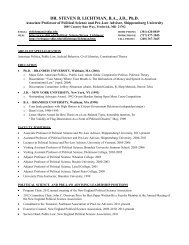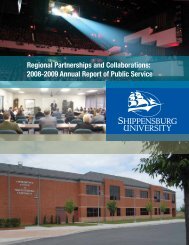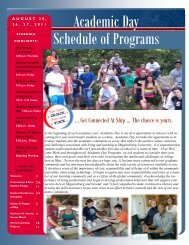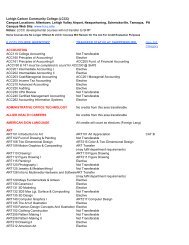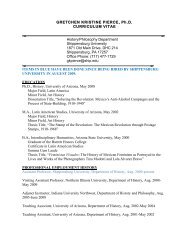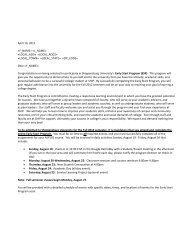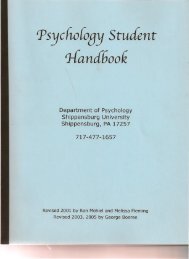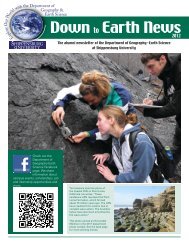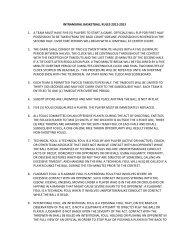Complete Issue - Shippensburg University
Complete Issue - Shippensburg University
Complete Issue - Shippensburg University
- No tags were found...
You also want an ePaper? Increase the reach of your titles
YUMPU automatically turns print PDFs into web optimized ePapers that Google loves.
37Winters in Salmon Country:The Nez Perce Tribe’s InstreamFlow ClaimsM a r k D. So l o m o nU niversity o f Id a h oA State Court RulesAs the first snows of the 2000 water year startedfalling in the high country, Idaho Fifth District JudgeBarry Wood issued his decision ruling against the NezPerce Tribe’s claims for instream water flows in Idaho’sSnake River basin. 1 Judge Wood, presiding over theSnake River Basin Adjudication (SRBA), handed downhis ruling in a state courtroom in Twin Falls, Idaho: 286miles by air, 390 miles by road, 630 miles by river, and aworld away from tribal headquarters in Lapwai on theNez Perce Reservation. Tying together the Nez PerceTribe and the farmers of the Snake River basin was theriver and the common need for water to survive in thearid American West. Dividing them were the ruggedmountains and steep canyons of central Idaho, onehundred fifty years of physical and legal conflict, and acultural gulf with few, if any, bridges.Judge Wood ruled that while the 1855 Nez PerceTreaty with the federal government guaranteed theNez Perce the “right of taking fish at all usual andaccustomed places in common with the citizens of theterritory,” it did not guarantee them there would everagain would be fish to be fished for at those places.Wood then raised the stakes for the tribe by rulingthat the tribal reservation allotment program of thefederal government in the late 1890s had diminishedthe extent of the Tribe’s sovereignty over its ownreservation, raising the possibility of tribal extinction. 2He concluded “the Nez Perce do not have Indianreserved instream flow water rights extending beyondthe boundaries of the present Reservation, where everthose boundaries may be.” 3The court’s order was immediately appealed bythe tribe to the Idaho Supreme Court along witha companion suit seeking removal of Judge Woodfrom the SRBA court due to a previously undisclosedapparent conflict of interest. Prior to hearing onappeal, the parties to the ruling agreed to settlementmediation and a stay of proceedings. The mediationwas successfully completed in 2004. History and theriver continue to flow.The Nez Perce People and their LandThe Nimi’puu, the Nez Perce people, have livedin what we now call portions of Idaho, Oregon, andWashington since time immemorial. 4 At the time offirst contact with Anglo civilization in 1803, whenLewis and Clark descended half-starved from theClearwater Mountains into the camas and salmoncountry of the Nez Perce, this people’s aboriginallands covered fourteen million acres stretching fromthe Wallowa country in the west to the BitterrootMountains in the east, from the headwaters of theSalmon River in the south to the Palouse River inthe north. Never a single tribe as much as a collectionof individual bands related by blood and customoccupying different areas within their territory, the aband followed the seasons from camp to camp, meetingwith the other Nez Perce bands when the camas rootwas ready to dig and the salmon ran in the rivers. 5The Snake River and its major tributaries – theSalmon, Grande Ronde and Clearwater rivers – definethe land of the Nez Perce. The Snake, flowing at anaverage rate of thirty-six million acre-feet per yearat present-day Lewiston, Idaho, 6 also defines thefreshwater world of the salmon runs that once filledits creeks, rivers and lakes. Historically, salmon runswere estimated to have ranged from five million toeight million adult fish annually in the Snake and itstributaries. 7In the traditions of the Yakama, Umatilla, WarmSprings, and Nez Perce, the spirit of the salmon—Mark D. Solomon is a doctoral candidate in the <strong>University</strong> of Idaho’s interdisciplinary Waters of the West Program. Aformer Latah County (Idaho) commissioner, he has been recognized as one of the Thirty Heroes of the Clean WaterAct (2002) for his commitment and ability as an advocate for the protection of the nation’s water resources.



